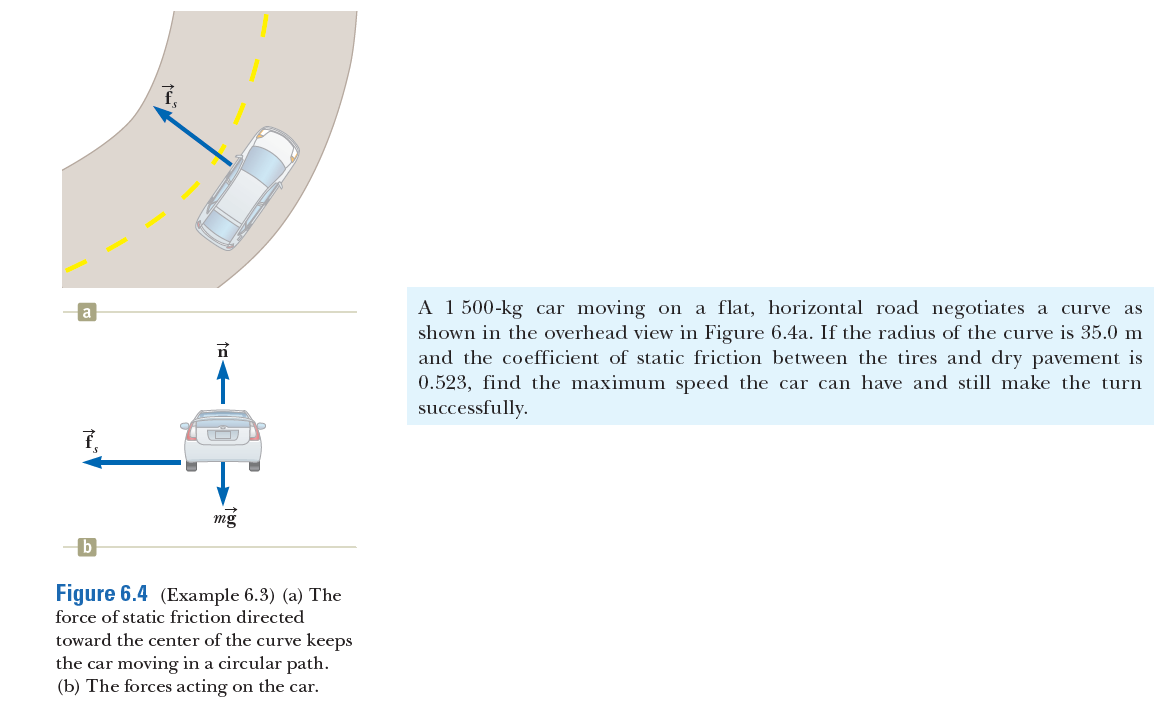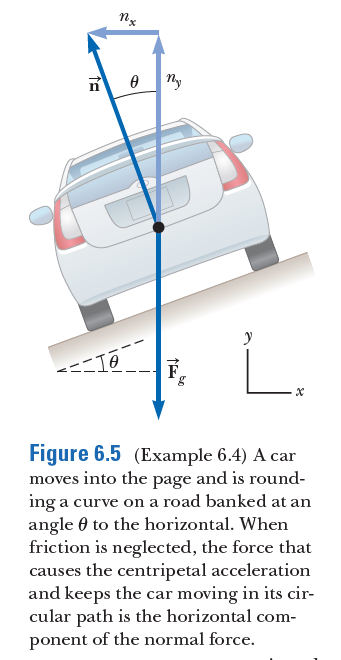A 1 500-kg car moving on a flat, horizontal road negotiates a curve as shown in the overhead view in Figure 6.4a. If the radius of the curve is 35.0 m and the coefficient of static friction between the tires and dry pavement is a 0.523, find the maximum speed the car can have and still make the turn successfully. O mg Figure 6.4 (Example 6.3) (a) The force of static friction directed toward the center of the curve keeps the car moving in a circular path. (b) The forces acting on the car. ーこニI Figure 6.5 (Example 6.4) A car moves into the page and is round- ing a curve on a road banked at an angle 0 to the horizontal. When friction is neglected, the force that causes the centripetal acceleration and keeps the car moving in its cir- cular path is the horizontal com- ponent of the normal force.
A 1 500-kg car moving on a flat, horizontal road negotiates a curve as shown in the overhead view in Figure 6.4a. If the radius of the curve is 35.0 m and the coefficient of static friction between the tires and dry pavement is a 0.523, find the maximum speed the car can have and still make the turn successfully. O mg Figure 6.4 (Example 6.3) (a) The force of static friction directed toward the center of the curve keeps the car moving in a circular path. (b) The forces acting on the car. ーこニI Figure 6.5 (Example 6.4) A car moves into the page and is round- ing a curve on a road banked at an angle 0 to the horizontal. When friction is neglected, the force that causes the centripetal acceleration and keeps the car moving in its cir- cular path is the horizontal com- ponent of the normal force.
Chapter2: Loads On Structures
Section: Chapter Questions
Problem 1P
Related questions
Question
You are a civil engineer who has been given the assignment to redesign the curved roadway in Example 6.3 in such a way that a car will not have to rely on friction to round the curve without skidding. In other words, a car moving at the designated speed can negotiate the curve even when the road is covered with ice. Such a road is usually banked, which means that the roadway is tilted toward the inside of the curve. Suppose the designated speed for the road is to be 13.4 m/s (30.0 mi/h) and the radius
of the curve is 35.0 m. You need to determine the angle at which the roadway on the curve should be banked.

Transcribed Image Text:A 1 500-kg car moving on a flat, horizontal road negotiates a curve as
shown in the overhead view in Figure 6.4a. If the radius of the curve is 35.0 m
and the coefficient of static friction between the tires and dry pavement is
a
0.523, find the maximum speed the car can have and still make the turn
successfully.
O
mg
Figure 6.4 (Example 6.3) (a) The
force of static friction directed
toward the center of the curve keeps
the car moving in a circular path.
(b) The forces acting on the car.

Transcribed Image Text:ーこニI
Figure 6.5 (Example 6.4) A car
moves into the page and is round-
ing a curve on a road banked at an
angle 0 to the horizontal. When
friction is neglected, the force that
causes the centripetal acceleration
and keeps the car moving in its cir-
cular path is the horizontal com-
ponent of the normal force.
Expert Solution
This question has been solved!
Explore an expertly crafted, step-by-step solution for a thorough understanding of key concepts.
This is a popular solution!
Trending now
This is a popular solution!
Step by step
Solved in 3 steps

Knowledge Booster
Learn more about
Need a deep-dive on the concept behind this application? Look no further. Learn more about this topic, civil-engineering and related others by exploring similar questions and additional content below.Recommended textbooks for you


Structural Analysis (10th Edition)
Civil Engineering
ISBN:
9780134610672
Author:
Russell C. Hibbeler
Publisher:
PEARSON

Principles of Foundation Engineering (MindTap Cou…
Civil Engineering
ISBN:
9781337705028
Author:
Braja M. Das, Nagaratnam Sivakugan
Publisher:
Cengage Learning


Structural Analysis (10th Edition)
Civil Engineering
ISBN:
9780134610672
Author:
Russell C. Hibbeler
Publisher:
PEARSON

Principles of Foundation Engineering (MindTap Cou…
Civil Engineering
ISBN:
9781337705028
Author:
Braja M. Das, Nagaratnam Sivakugan
Publisher:
Cengage Learning

Fundamentals of Structural Analysis
Civil Engineering
ISBN:
9780073398006
Author:
Kenneth M. Leet Emeritus, Chia-Ming Uang, Joel Lanning
Publisher:
McGraw-Hill Education


Traffic and Highway Engineering
Civil Engineering
ISBN:
9781305156241
Author:
Garber, Nicholas J.
Publisher:
Cengage Learning